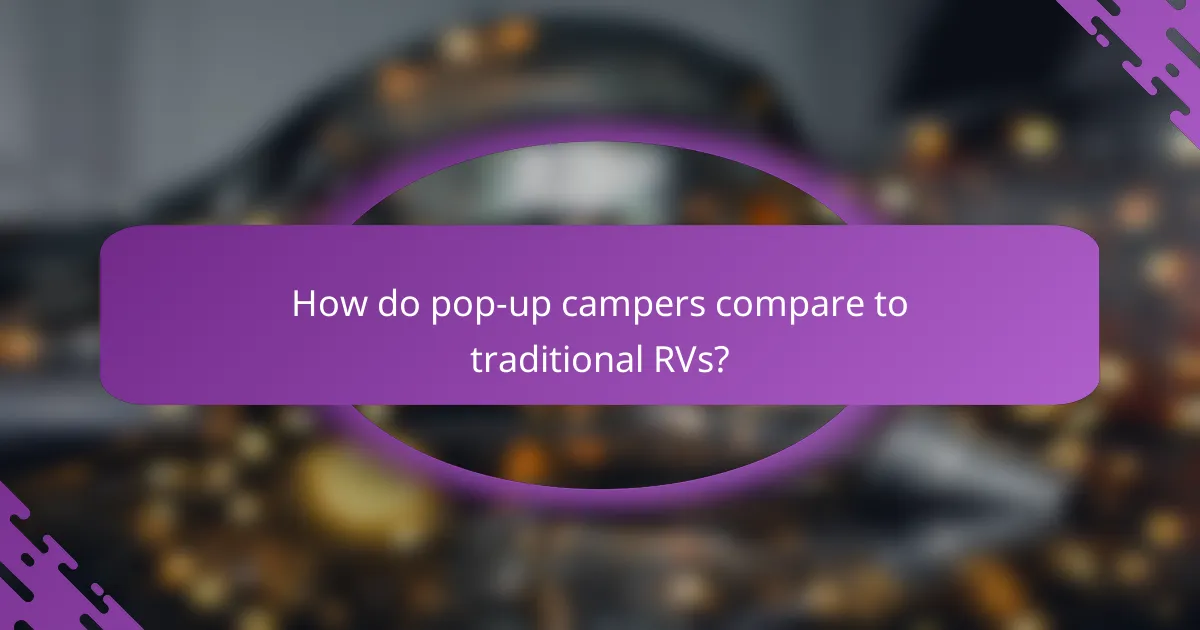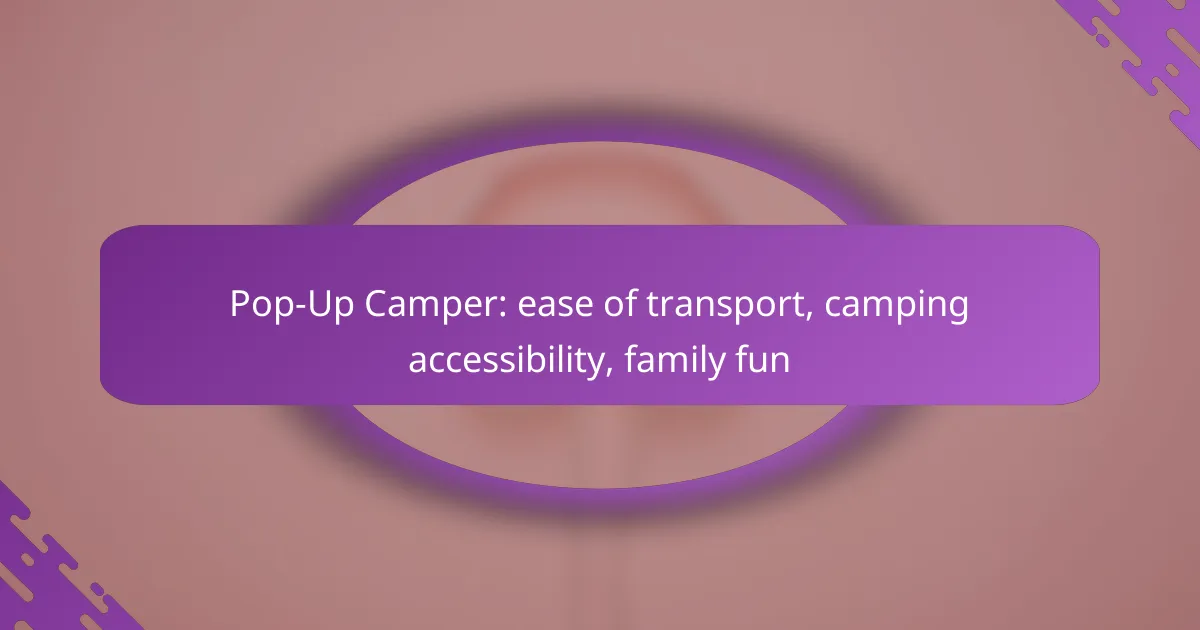Pop-up campers are an excellent solution for families seeking convenience and accessibility in their outdoor adventures. With their lightweight design and quick setup, they make camping more approachable, allowing for memorable experiences without the complexities of traditional RVs. Ideal for exploring diverse locations, pop-up campers blend comfort with ease of transport, ensuring that every trip is enjoyable for the whole family.

How do pop-up campers enhance camping accessibility in Canada?
Pop-up campers significantly improve camping accessibility in Canada by offering a convenient and flexible way to enjoy the outdoors. Their lightweight design and ease of setup make them ideal for families and individuals looking to explore various camping locations without the hassle of traditional RVs.
Lightweight design for easy towing
Pop-up campers are designed to be lightweight, typically weighing between 1,000 to 3,000 pounds, which allows them to be towed by a wide range of vehicles, including smaller SUVs and trucks. This feature makes them accessible for many Canadian families who may not own heavy-duty towing vehicles.
Before purchasing a pop-up camper, check your vehicle’s towing capacity to ensure compatibility. This will help avoid any potential safety issues while on the road.
Quick setup for spontaneous trips
One of the standout features of pop-up campers is their quick setup time, often taking just 10 to 15 minutes. This allows families to embark on spontaneous camping trips without the need for extensive preparation or planning.
To streamline the setup process, familiarize yourself with the camper’s features and practice setting it up at home. This will make your first camping experience much smoother and more enjoyable.
Affordable camping option for families
Pop-up campers are generally more affordable than traditional RVs, with prices ranging from a few thousand to around $20,000 CAD, making them a budget-friendly option for families. This affordability allows more people to experience camping without breaking the bank.
Consider the long-term savings associated with pop-up campers, such as lower fuel costs and maintenance expenses compared to larger RVs. This makes them an attractive choice for families looking to enjoy outdoor adventures without overspending.

What are the benefits of using a pop-up camper for family trips?
Pop-up campers offer a blend of convenience and comfort for family trips, making them an excellent choice for outdoor adventures. They are easy to transport, provide essential amenities, and create memorable experiences for families.
Comfortable sleeping arrangements
Pop-up campers typically feature multiple sleeping areas, accommodating families of various sizes. Most models come with comfortable mattresses, allowing for a restful night’s sleep after a day of activities. Some campers even have additional features like privacy curtains and built-in storage for personal items.
When selecting a pop-up camper, consider the layout and size of the sleeping spaces. Many campers can comfortably sleep four to six people, making them ideal for family trips.
Space for family activities
Pop-up campers provide ample space for family activities, both inside and outside. The expandable design allows for a cozy interior where families can gather, play games, or enjoy meals together. Many models include a dinette area that can convert into additional sleeping space if needed.
Additionally, the outdoor setup often includes an awning, creating a shaded area for cooking, relaxing, or socializing. This versatility enhances the camping experience, making it easier to enjoy quality time together.
Cost-effective compared to hotels
Using a pop-up camper can be significantly more cost-effective than booking hotel rooms, especially for extended trips. Campground fees are generally lower than hotel rates, and families can save on meals by cooking in the camper. This combination can lead to substantial savings over time.
Moreover, pop-up campers can be rented at reasonable rates, making them accessible for families who may not want to invest in purchasing one outright. This affordability allows families to explore various camping locations without breaking the bank.

What features should you consider when choosing a pop-up camper?
When selecting a pop-up camper, consider size, weight, interior amenities, and durability. These features significantly impact transport ease, camping accessibility, and overall family fun.
Size and weight specifications
The size and weight of a pop-up camper are crucial for transport and towing. Most models weigh between 1,000 to 3,000 pounds, making them manageable for many SUVs and trucks. Ensure your vehicle’s towing capacity aligns with the camper’s weight to avoid safety issues.
Additionally, consider the camper’s dimensions when set up. A compact model may be easier to maneuver in tight camping spots, while a larger one can provide more living space for family activities.
Interior amenities and layout
Interior amenities significantly enhance the camping experience. Look for features like a kitchenette, dining area, and sleeping arrangements that suit your family’s needs. Some models offer slide-outs for additional space, while others may include bathrooms or storage solutions.
Evaluate the layout to ensure it accommodates your family’s size and preferences. A well-designed interior can make a small camper feel spacious and functional, allowing for enjoyable family time during your trips.
Durability and weather resistance
Durability and weather resistance are vital for ensuring your pop-up camper lasts through various conditions. Look for models constructed with high-quality materials, such as aluminum frames and weather-resistant fabrics. These features help protect against rain, wind, and UV exposure.
Additionally, consider the camper’s insulation properties. Good insulation can keep the interior comfortable in both hot and cold weather, enhancing your camping experience year-round. Regular maintenance, such as checking seals and fabric integrity, will also prolong the camper’s lifespan.

How do pop-up campers compare to traditional RVs?
Pop-up campers are generally more affordable and easier to transport than traditional RVs, making them a popular choice for families seeking camping accessibility and fun. They offer a balance of comfort and convenience while being less cumbersome than larger recreational vehicles.
Lower purchase and maintenance costs
Pop-up campers typically have a lower initial purchase price compared to traditional RVs, often ranging from a few thousand to around ten thousand USD. This affordability makes them accessible for families who want to enjoy camping without a significant financial commitment.
Maintenance costs for pop-up campers are usually lower as well. They have simpler systems and fewer components, which means repairs and upkeep can be less frequent and less expensive compared to the more complex systems found in larger RVs.
Better fuel efficiency
Pop-up campers are lighter than traditional RVs, which translates to better fuel efficiency when towing. Many vehicles can tow them without requiring a heavy-duty truck, allowing for a wider range of options for families.
On average, towing a pop-up camper can improve fuel economy by tens of percent compared to towing a larger RV. This efficiency can lead to significant savings on fuel costs during camping trips.
More compact for storage
Pop-up campers fold down into a compact size, making them easier to store when not in use. This is particularly beneficial for families with limited space, as they can fit in standard garages or smaller storage units.
In contrast, traditional RVs require more space and often need specialized parking or storage solutions, which can add to the overall cost and complexity of ownership. The compact nature of pop-up campers simplifies logistics for families looking to maximize their camping experiences.

What are the best pop-up camper brands available in Canada?
Some of the top pop-up camper brands in Canada include Forest River Rockwood, Jayco Jay Series, and Starcraft Comet. These brands are known for their quality, durability, and family-friendly features, making them popular choices among Canadian campers.
Forest River Rockwood
Forest River Rockwood pop-up campers are well-regarded for their robust construction and innovative designs. They often feature amenities like spacious interiors, high-quality materials, and efficient heating systems, making them suitable for various weather conditions.
When considering a Rockwood model, look for options that include slide-outs for extra living space and upgraded kitchen features. Their models typically range from around 1,500 to 3,000 CAD, depending on the size and features.
Jayco Jay Series
The Jayco Jay Series is known for its user-friendly design and family-oriented features. These campers often come equipped with comfortable sleeping arrangements and ample storage, making them ideal for family trips.
Jayco models are generally priced between 10,000 and 20,000 CAD, with various configurations to suit different family sizes. Pay attention to the warranty options, as Jayco offers one of the best in the industry, which can provide peace of mind for new buyers.
Starcraft Comet
Starcraft Comet pop-up campers are designed for those seeking a balance between affordability and functionality. They are lightweight, making them easy to tow, and often include essential features like a kitchen and bathroom facilities.
Prices for Starcraft Comet models typically range from 8,000 to 15,000 CAD. When choosing a model, consider the weight and towing capacity of your vehicle to ensure a safe and enjoyable camping experience.

What are common maintenance tips for pop-up campers?
Regular maintenance is essential for keeping pop-up campers in good condition and ensuring a safe camping experience. Key maintenance tasks include checking for leaks, inspecting the tires, and maintaining the canvas and hardware.
Inspect the Canvas
Regularly check the canvas for tears, mildew, or signs of wear. Clean the fabric with a mild soap solution and allow it to dry completely to prevent mold growth. Consider applying a waterproofing spray annually to maintain its integrity.
Check the Tires
Inspect the tires for proper inflation and tread wear before each trip. Maintaining the correct tire pressure can improve fuel efficiency and ensure safe towing. Replace tires that show significant wear or have cracks, typically every few years depending on usage.
Test the Electrical System
Periodically check the camper’s electrical system, including lights and outlets, to ensure everything is functioning properly. Test the battery and replace it if it shows signs of weakness, usually every 2-3 years. Keep connections clean and free from corrosion.
Maintain the Frame and Hardware
Inspect the frame and hardware for rust or damage. Regularly lubricate moving parts, such as hinges and latches, to ensure smooth operation. Address any rust immediately with appropriate treatments to prolong the life of the camper.
Store Properly
When not in use, store the pop-up camper in a dry, shaded area to protect it from the elements. Use a breathable cover to prevent moisture buildup while allowing air circulation. This practice can significantly extend the lifespan of the camper’s materials.
